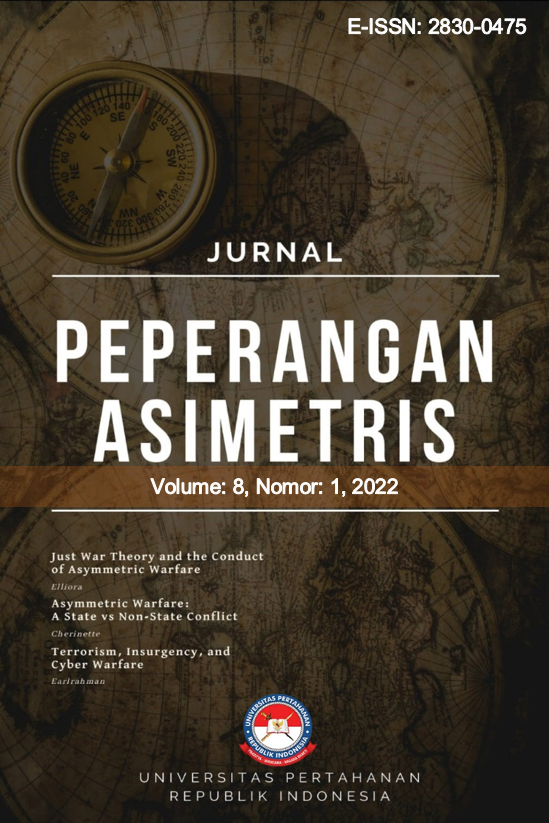STRATEGI PERTAHANAN NEGARA INDONESIA DALAM MENGHADAPI ANCAMAN ARTIFICIAL INTELLIGENCE
DOI:
https://doi.org/10.33172/pa.v8i1.1181Abstrak
Artificial Intelligence (AI) adalah elemen penting dari era yang disebut
sebagai Revolusi Industri Keempat. Teknologi dan aplikasi AI memiliki dampak
yang luar biasa. AI telah mulai membuat dampak yang siginifikan dalam urusan
militer dan strategis. Permasalahan penelitian adalah strategi pertahanan Indonesia dalam menghadapi ancaman AI. Tujuan dari penelitian ini adalah untuk mengetahui strategi pertahanan Indonesia dalam menghadapi ancaman AI. Penelitian ini menggunakan metode kualitatif dengan pendekatan deskriptif analitis, serta data diperoleh dari wawancara dan studi dokumentasi. Peneliti mewawancarai para informan yang telah ditunjuk dan mengumpulkan data sekunder, kemudian dianalisis menggunakan teknik analisa data Miles-Huberman, Saldana tahun 2014. Hasil penelitian ini adalah AI merupakan ancaman terhadap pertahanan Negara, penggunaan AI dalam pertahanan Negara mempengaruhi superioritas militer maupun informasi. Strategi dalam menghadapi ancaman penggunaan AI dalam pertahanan meliputi pembuatan berbagai kebijakan, UU dan peraturan yang memadai sebagai dasar, pemantapan kemampuan intelijen untuk memahami perkembangan ancaman AI, pembangunan industri pertahanan dalam negeri, perekrutan dan pelatihan sumber daya manusia yang berkelanjutan, pembangunan kekuatan yang terintegrasi diantara komponen utama, cadangan dan pendukung.
Sarana yang digunakan dalam menghadapi ancaman penggunaan AI dalam
pertahanan adalah alat-alat dengan teknologi AI baik yang dibeli dari luar negeri
atau diproduksi sendiri dalam negeri.
Kata Kunci: Ancaman, Artificial Intelligence, Pertahanan Indonesia, Strategi,
Teknologi
Referensi
Congressional Research Service. (2018). U.S. Ground Forces Robotics and Autonomous
Systems (RAS) and Artificial Intelligence (AI): Considerations for Congress. CRS.
Corrigan, J. (2017, November 3). Three-Star General Wants AI in Every New Weapon
System. Retrieved from Defense One:
https://www.defenseone.com/technology/2017/11/three-star-general-wantsartificial-
intelligence-every-new-weapon-system/142239/
Macri, G. (2016, September 13). NSA Chief Says Without Artificial Intelligence, Cyber ‘Is
a Losing Strategy’. Retrieved from Inside Sources:
https://www.insidesources.com/nsa-chief-without-ai-cyber-is-a-losingstrategy/#:~:
text=Technology-
,NSA%20Chief%20Says%20Without%20Artificial,Cyber%20'Is%20a%20Losin
g%20Strategy'&text=Michael%20Rogers%2C%20who%20told%20Congress,%
E2%80%9Cis%20a%20losing%20s
Organisation for Economic Co-operation and Development (OECD). (2016). OECD
Science, Technology and Innovation Outlook 2016.
Roth, M. (2019, Februari 22). Artificial Intelligence in the Military – An Overview of
Capabilities. Retrieved from Emerj: https://emerj.com/ai-sectoroverviews/
artificial-intelligence-in-the-military-an-overview-of-capabilities/
Svenmarck, Peter et al. (2018). Possibilities and Challenges for Artificial Intelligence
in Military Applications. NATO Big Data and Artificial Intelligence for Military
Decision Making Specialists’ Meeting. NATO Science and Technology
Organisation.
Weisgerber, M. (2017, September 19). Defense Firms to Air Force: Want Your Planes’
Data? Pay Up. Retrieved from Defense One:
http://www.defenseone.com/technology/2017/09/military-planes-predictivemaintenance-
technology/141133/
Work, R. O., & Brimley, S. (2014). 20YY: Preparing for War in the Robotic Age.
Washington D.C.: Center for a New American Security
Unduhan
Diterbitkan
Cara Mengutip
Terbitan
Bagian
Lisensi
Proposed Policy for Journals That Offer Open Access. Authors who publish with this journal agree to the following terms:
- Authors retain copyright and grant the journal right of first publication with the work simultaneously licensed under a Creative Commons Attribution License that allows others to share the work with an acknowledgment of the work's authorship and initial publication in this journal.
- Authors are able to enter into separate, additional contractual arrangements for the non-exclusive distribution of the journal's published version of the work (e.g., post it to an institutional repository or publish it in a book), with an acknowledgment of its initial publication in this journal.
- Authors are permitted and encouraged to post their work online (e.g., in institutional repositories or on their website) prior to and during the submission process, as it can lead to productive exchanges, as well as earlier and greater citation of published work (See The Effect of Open Access).
Proposed Policy for Journals That Offer Delayed Open Access. Authors who publish with this journal agree to the following terms:
- Authors retain copyright and grant the journal right of first publication, with the work [SPECIFY PERIOD OF TIME] after publication simultaneously licensed under a Creative Commons Attribution License that allows others to share the work with an acknowledgment of the work's authorship and initial publication in this journal.
- Authors are able to enter into separate, additional contractual arrangements for the non-exclusive distribution of the journal's published version of the work (e.g., post it to an institutional repository or publish it in a book), with an acknowledgment of its initial publication in this journal.

